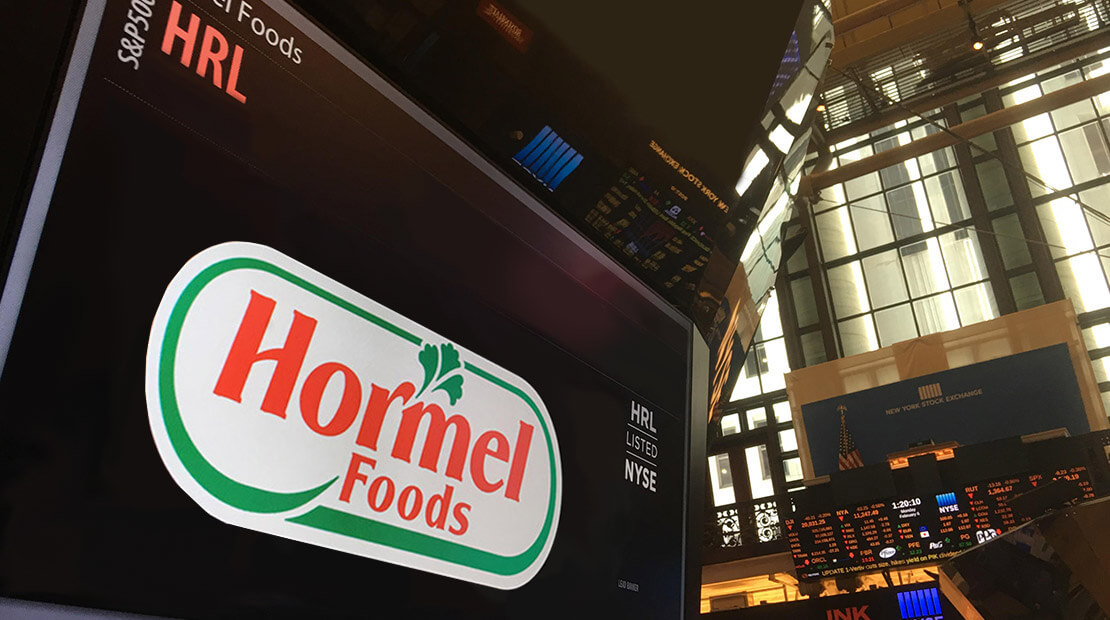About Hormel Foods – Inspired People. Inspired Food.™
Hormel Foods Corporation, based in Austin, Minn., is a global branded food company with over $12 billion in annual revenue across more than 80 countries worldwide. Its brands include Planters®, Skippy®, SPAM®, Hormel® Natural Choice®, Applegate®, Justin’s®, Wholly®, Hormel® Black Label®, Columbus®, Jennie-O® and more than 30 other beloved brands. The company is a member of the S&P 500 Index and the S&P 500 Dividend Aristocrats, was named on the “Global 2000 World’s Best Employers” list by Forbes magazine for three years, is one of Fortune magazine’s most admired companies, has appeared on the “100 Best Corporate Citizens” list by 3BL Media 13 times, and has received numerous other awards and accolades for its corporate responsibility and community service efforts. The company lives by its purpose statement — Inspired People. Inspired Food.™ — to bring some of the world’s most trusted and iconic brands to tables across the globe. For more information, visit www.hormelfoods.com and https://www.hormelfoods.com/global-impact/.
FORWARD-LOOKING STATEMENTS
This news release contains “forward-looking” information within the meaning of the federal securities laws. The “forward-looking” information may include statements concerning the Company’s outlook for the future as well as other statements of beliefs, future plans, strategies, or anticipated events and similar expressions concerning matters that are not historical facts. Words or phrases such as “should result,” “believe,” “intend,” “plan,” “are expected to,” “targeted,” “will continue,” “will approximate,” “is anticipated,” “estimate,” “project,” or similar expressions are intended to identify forward-looking statements. Such statements are subject to certain risks and uncertainties that could cause actual results to differ materially from historical earnings and those anticipated or projected, which factors include, but are not limited to, risks related to the deterioration of economic conditions; risks associated with acquisitions, joint ventures, equity investments, and divestitures; potential disruption of operations, including at co-manufacturers, suppliers, logistics providers, customers, or other third-party service providers; failure to realize anticipated cost savings or operating efficiencies associated with strategic initiatives; risk of loss of a material contract; the Company’s inability to protect information technology systems against, or effectively respond to, cyber attacks or security breaches; deterioration of labor relations, labor availability or increases to labor costs; general risks of the food industry, including food contamination; outbreaks of disease among livestock and poultry flocks; fluctuations in commodity prices and availability of raw materials and other inputs; fluctuations in market demand for the Company’s products; damage to the Company’s reputation or brand image; climate change, or legal, regulatory, or market measures to address climate change; risks of litigation; potential sanctions and compliance costs arising from government regulation; compliance with stringent environmental regulations and potential environmental litigation; and risks arising from the Company’s foreign operations. Please refer to the cautionary statements regarding “Risk Factors” and “Forward-Looking Statements” that appear in our most recent Annual Report on Form 10-K and Quarterly reports on Form 10-Q, which can be accessed at www.hormelfoods.com in the “Investors” section, for additional information. In making these statements, the Company is not undertaking, and specifically declines to undertake, any obligation to address or update each or any factor in future filings or communications regarding the Company’s business or results, and is not undertaking to address how any of these factors may have caused changes to discussions or information contained in previous filings or communications. Though the Company has attempted to list comprehensively these important cautionary risk factors, the Company wishes to caution investors and others that other factors may in the future prove to be important in affecting the Company’s business or results of operations. The Company cautions readers not to place undue reliance on forward-looking statements, which represent current views as of the date made.
Note: Due to rounding, numbers presented throughout this news release may not sum precisely to the totals provided, and percentages may not precisely reflect the absolute figures.
END NOTES
1COMPARISON OF U.S. GAAP TO NON-GAAP FINANCIAL MEASURES
Fourth Quarter and Year-end Results
The non-GAAP financial measures of adjusted selling, general and administrative expenses as a percent of net sales, adjusted operating income, adjusted operating margin, adjusted earnings before income taxes, adjusted diluted net earnings per share, and adjusted segment profit are presented to provide investors with additional information to facilitate the comparison of past and present operations. Adjusted selling, general and administrative expenses as a percent of net sales excludes the impact of an adverse arbitration ruling and certain costs associated with the transformation and modernization initiative. Adjusted operating income, adjusted operating margin, adjusted earnings before income taxes, and adjusted diluted net earnings per share excludes the impact of an adverse arbitration ruling, impairment charges associated with the Justin’s® trade name and a corporate venturing investment, and costs associated with the transformation and modernization initiative. The tax impact was calculated using the effective tax rate for the quarter in which the expense was incurred. The non-GAAP financial measure of adjusted segment profit for the Retail segment excludes the impact of a non-cash impairment charge associated with the Justin’s® trade name.
The Company believes these non-GAAP financial measures provide useful information to investors because they are the measures used to evaluate performance on a comparable year-over-year basis. Non-GAAP measures are not intended to be a substitute for GAAP measures in analyzing financial performance. These non-GAAP measures are not in accordance with generally accepted accounting principles and may be different from non-GAAP measures used by other companies.
